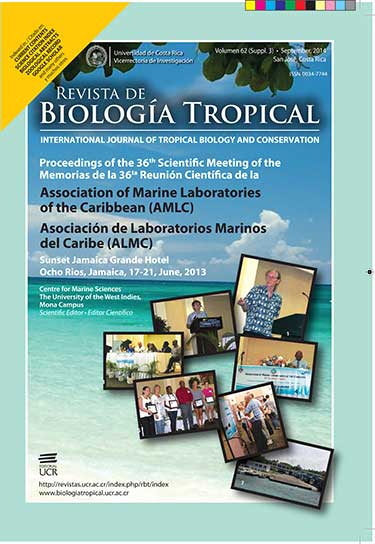Abstract
Spearfishing was becoming an increasingly important economic activity in the Caribbean as a result of socioeconomic factors related to underemployment and the low capital outlay for equipment. For a year (2011) we surveyed spearfishing in 23 Jamaican beaches. Spearfishing has expanded from approximately 1% of fishers in 1991 to about 10% in 2011. The fishery is larger than expected and probably produced 4 000tons per year. Though reef fishes dominated catches, other resources such as lobsters, conch and octopus were regularly taken. Many small juvenile fishes were observed in catches well below their adult or optimum sizes. A total of 58% of spear-fishers reported they would have significant difficulty findingalternative employment if spearfishing was banned. Spearfishers reported exploiting the entire island shelf and also nearly all the offshore banks, especially Pedro Bank. Night spearfishing was common and targeted sleeping reef fishes. The activity is banned and should be enforced. Our recommendations include: register all spearfishers, actively manage spearfishing, apartial ban for part of the year and a ban on using scuba and hookah gear for spearfishing. Rev. Biol. Trop. 62 (Suppl. 3): 141-149. Epub 2014 September 01.References
Aiken, K. A. (1993) Jamaica, Marine Fishery Resources of the Antilles: Lesser Antilles Puerto Rico, Cuba, Jamaica and Hispaniola. FAO Fish Technical Paper, 326, 1160-1180
Aiken, K. A. (2008). The USAID-Protected Areas and Rural Enterprise Project (Jamaica). Sector Position Paper on Fisheries, Consultant’s report.
CFRAMP. (2000). Jamaica National Marine Fisheries Atlas. Fishery Report No. 4. Kingston, Jamaica: CARICOM
Halcrow, S. W. (1998). South Coast Sustainable Development Study: Phase 1. Technical report 2. Government of Jamaica, Kingston, Jamaica: Marine Resources.
Munro, J. L. (1983). Caribbean Coral Reef Fishery Resources. Manila, Philippines: ICLARMP Special Publications.
FWC. (2011). Saltwater Regulations spearing. The Florida Fish and Wildlife Conservation Commission. Retrieved from http://myfwc.com/RULESANDREGS/Saltwater_Regulations_spearing.htm,
Passley, D. (2009). Characterization of Jamaican Spearfishing Activities. Research Report for Research Project course BIOL3018, Department of Life Sciences, Faculty of Pure & Applied Sciences, University of the West Indies, Mona campus.
Passley, D., Aiken K., & Perry, G. (2010). First characterization of the Jamaican spearfishing sub-sector. Proceedings of Gulf and Caribbean Fisheries Institute, 62, 235-240.
Roberts, C. (2007). The Unnatural History of the Sea. Washington D.C.: Island Press.
Sary, Z. (2001). The Small Scale Reef Fishery on the Central North Coast of Jamaica in 2000-2001: A Biological and Socio-Economic Survey. ICLARM, The Islands of the Bahamas, 2008-2011. Retrieved from http://www.bahamas.com/bahamas/regulations-0.
##plugins.facebook.comentarios##

This work is licensed under a Creative Commons Attribution 4.0 International License.
Copyright (c) 2014 Revista de Biología Tropical


